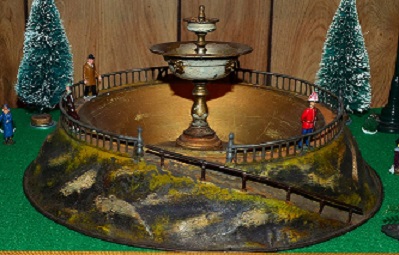By Roland Digilio

When meeting another collector for the first time, the conversation will invariably turn to what we collect. Often, upon explaining that I collect fountains, among other things, I usually get a puzzled look, so I thought I would share some of my fountains and the history behind them.
I don’t know when the first toy fountains were made, but they do appear in the German toy catalogs of the late 1800s. Some of them were operated by gravity: there is generally a landscape with a tank or reservoir close to the top, and below a spout of some sort, such as a spray head or possibly an imitation pump and water trough. Image A is such a piece. The reservoir is the rocky outcropping near the top. The water flows over the water wheel, causing the trip hammers to move up and down.
Many of the fountains I have encountered are the types that use a pump to move the water. These typically have a pulley operated pump.
The companies that made this type of fountain generally made stationary steam engines as scientific models. Once they had created the steam engines they needed something to run with the rotational power produced by the engine. The manufacturers created what are known colloquially as pulley toys. They made moving figures, Ferris wheels, carousels, and other amusement park rides. At some point someone came to the conclusion that the same type of cylinder and piston used to create rotary motion from steam pressure could be used to create water pressure by imparting that rotary motion to the pulley on the pump (the motion supplied, hopefully, by one of their steam engines).
Fountains were made by most of the German manufacturers, including Märklin, Bing, Carette, Doll, Falk, Plank, Schöenner, and M&K.
Some are very simple, such as the Doll fountain (F). This was my first fountain and all of its paint has fallen off.
Some of the fountains are quite ornate, employing more than one spray or spout. Some of the largest have eight or nine jets and as many as three pump cylinders to create enough pressure and flow to make all of the jets active. Image G is a Bing fountain with four jets and two pumps.
The fountains come in various sizes from the small Bing (I), to the absolutely huge Märklin fountain (B) (approximately 16” diameter).
These are just a few of the hundreds of different toy fountains that are out there. When you see one, you will now know what it is. I am always happy to talk about fountains and to share my collection.
